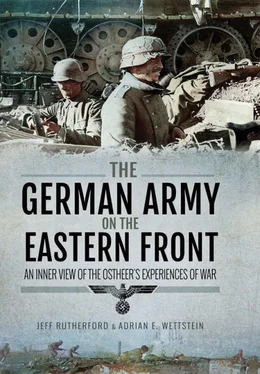Altrichter’s recommendations on training are rather surprising, as they do not correspond to the common perception that the German army consisted of disciplined and stalwart officers in perfect uniforms. But the point here was about creating an esprit de corps , which was essential for the German command system, and which needed a unified understanding, as well as mutual confidence between superiors and subordinates, to work smoothly. This could be created by frank discussions in free and light-hearted situations. The German officer’s mess, or the Kasino , had the same aim, as described in another document written by the 58th Infantry Division’s commander: [13]
Kasino: Necessary institution to educate the [officers] community. Place for the exchange of thoughts, education for the care of camaraderie, of training. Model for the kasino [were] English clubs. Only introduced since the beginning of the 18th century. Food is service. No cliques.
A last thing to stress from this order was the position of the NCO in the German army, which differed from most armies of the time. Since the turn of the century, and in accordance with the idea of decentralized command, NCOs formed an essential part of German low-level leadership, normally leading platoons, groups, and individual heavy weapons. This is clearly pointed out in the ‘Guidelines for the training of the NCOs at the Field NCO Schools’: [14]
The modern method of combat has increased the importance of the NCOs. The fragmented combat method in the attack, the holding of wide sections by group-wise deployment, by strongpoints and nests, as well as by detachments kept ready for the immediate counter-thrust against an intruding enemy, places high demands on bold decision-making power and leadership. The cooperation of different weapons in a combat group requires tactical understanding and high practical abilities of the NCO.
The self-reliant NCO must be aware of his responsibility and the trust placed in him, and resolutely and deliberately carry out his mission.
Training and education were tightly connected in the German understanding of forming leaders (and soldiers too). While training should result in military competencies such as weapons handling or tactical understanding, education should infuse soldierly values in order for soldiers and officers to act intuitively in situations according to the common principles of the German army, without which the German command system would not function. In other words, education was the training of character. To give an idea what this meant for NCOs and how education should work, a further section of the Guidelines for the training of NCOs at the Field NCO Schools follows: [15]
The aim of the education is: a) Clear and serious concept of duty and profession, sense of responsibility and reliability. b) Confident and decided appearance as the basis for the teaching and leadership qualification. c) Crispness, determination and flexibility. d) Care for the subordinates. e) Good manners, tactful behaviour.
Means of education are: a) Tightly handled service. b) Accuracy in the performance of the service. c) Order and cleanliness. d) Cultivate good manners and comradeship in comradeship rooms and at dinner.
The high losses in leaders, however, made German efforts to provide leadership training increasingly futile. A few numbers should give an idea of the extent of these casualties: Losses on all fronts from autumn 1941–1944 totalled more than 54,000 army officers, of which the great majority occurred on the Eastern front. A further 7,000 army officers were lost in these years due to illness, accidents, suicides or death sentences. [16]The 18th Panzer Division entered the Soviet Union in June 1941 with 401 officers – at the end of July it had already lost 153. When the same division was sent into action on 11 July 1943 against the Soviet offensive to crack the Orel salient, it only had 157 officers available. After twelve days of intense fighting, only thirty officers were ready for duty. The 12th Infantry Division marched into the Soviet Union with 336 officers. In May 1942, cumulative loss of officers had risen to 341, as many as the division had possessed at the beginning of the invasion. [17]
In addition to the lack of officers and NCOs, a main problem of command was the means of communication. In the 1930s, Germany was among the world’s leaders in the use of radio equipment for the command of fast-moving motorized and armoured units. But the stocks of such equipment could not keep up with the massive expansion of the German army in the late 1930s and early 1940s. Following the doubling of armoured units in 1940/41 for the campaign in the east, the supply of radio equipment became a significant issue. Materials for the more conventional telephone communications were also lacking, especially cable. The production of communications material was always in competition with other items, be it for the use of rare raw materials such as copper, or for the special workers used for producing other electronic goods (radar equipment, searchlights for night air defence). The worker question also became important for the troops, since signal units needed specialists for operating and maintaining the radios and telephones. One has to keep in mind that electronic devices were not nearly as common then as today and the broad mass of the German population was unfamiliar with them. Exacerbating the lack of electronic equipment for communications were the shortages of men and vehicles for the signal troops. They were in need of all-terrain vehicles of military origin, specially designed to carry their communications equipment. Since there were never enough of these vehicles, be they half-tracks or wheeled, the communications troops had to rely more and more on improvised trucks that simply were not robust enough for the terrain in the east. This led to a vicious circle, as fewer and fewer operational communications vehicles were available. Even the spearhead Panzer divisions suffered from such shortages, as a late 1943 report by the divisional signal officer, typically the commander of the divisional signal battalion, from 8th Panzer Division indicates: [18]
[Divisional] Signal troops:
A) Telephony company
| Authorized strength |
actual strength: |
| 8 large telephone-construction teams |
3 large telephone-construction teams |
| 6 small telephone-construction teams |
3 small telephone-construction teams |
| 2 [telephone]operations teams |
2 [telephone]operations teams |
Of these, two are in repair on average.
Cable length: authorized: 182 lengths; actual: 68 lengths
Considering the motor vehicle and cable situation, the company is still limited operationally. The requirements of the tactical leadership concerning telephone communication in the current organization of the division can still be essentially met. In limited attacks, the company is still capable of establishing and maintaining telephone communications to one battle group.
Main difficulties of the company: Motor vehicle situation, cable stock.
B) Radio company:
| Authorized strength |
actual strength: |
| 1 medium command tank |
7 medium radio teams type b |
| 3 [light] command tanks |
3 medium radio teams type a |
| 2 [special-purpose motor vehicle] 267 (half-track) |
1 small radio teams type c |
| 1 [special-purpose motor vehicle] 268 (half-track) |
| 10 medium radio teams type a |
| 6 medium radio teams type a / f |
| 5 medium radio teams type b |
| 2 small radio teams type c |
By establishing the radio communications exclusively in ‘star’ traffic, [19]the company has until now been able to meet the requirements of the tactical leadership. The company does not have any reserves which allow for the establishment of new traffic connections during changes in the situation. A tactical connection must be cancelled if a radio station fails. Since there are no armoured radio stations available, the required intercommunication cannot be made. Main difficulty of the company: Motor vehicle situation and the obtaining of spare parts for electric generators (GG 400).
Читать дальше






![John Stieber - Against the Odds - Survival on the Russian Front 1944-1945 [2nd Edition]](/books/405234/john-stieber-against-the-odds-survival-on-the-russian-front-1944-1945-2nd-edition-thumb.webp)





